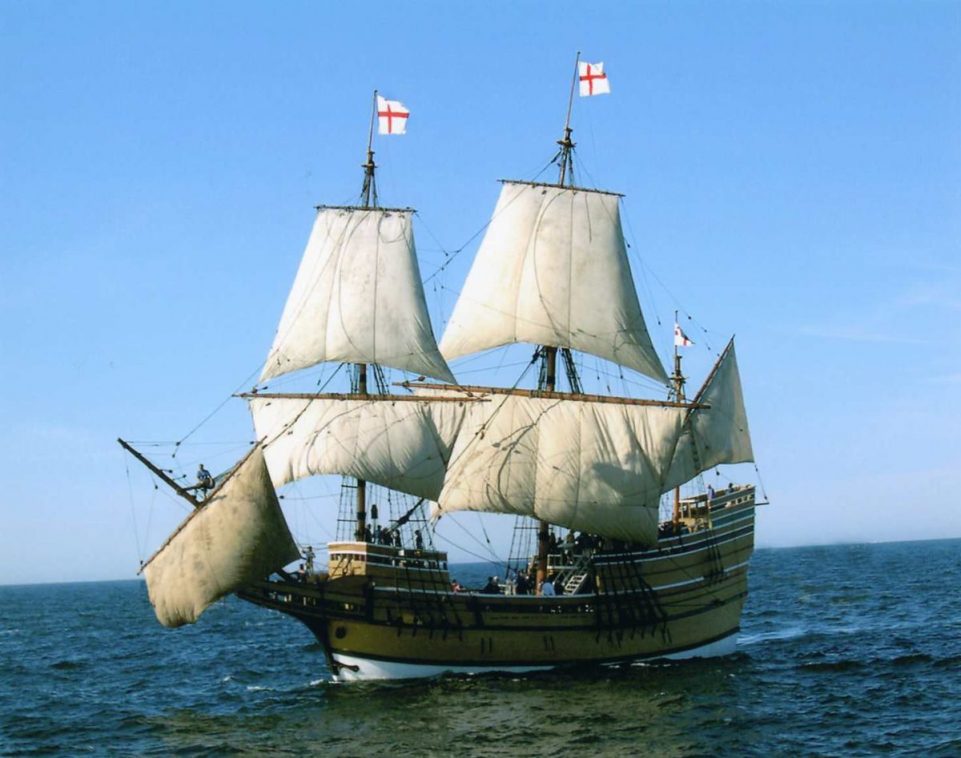First of two parts
In September 1620, a small ship called the Mayflower left Plymouth, England, carrying 102 passengers—an assortment of religious separatists seeking a new home where they could freely practice their faith and other individuals lured by the promise of prosperity and land ownership in the New World.
After a treacherous, uncomfortable crossing that lasted 66 days, they dropped anchor near the tip of Cape Cod, far north of their intended destination at the mouth of the Hudson River.
One month later, the Mayflower crossed Massachusetts Bay, where the Pilgrims, as they are now commonly known, began the work of establishing a village at Plymouth.
Did You Know?
Lobster, seal and swans were on the Pilgrims’ menu.
Throughout that first brutal winter, most of the colonists remained on board the ship, where they suffered from exposure, scurvy and outbreaks of contagious disease.
Only half of the Mayflower’s original passengers and crew lived to see their first New England spring.
In March, the remaining settlers moved ashore, where they received an astonishing visit from an Abenaki Indian who greeted them in English.
Several days later, he returned with another Native American, Squanto, a member of the Pawtuxet tribe.
He had been kidnapped by an English sea captain and sold into slavery before escaping to London and returning to his homeland on an exploratory expedition.
Squanto taught the Pilgrims, weakened by malnutrition and illness, how to cultivate corn, extract sap from maple trees, catch fish in the rivers and avoid poisonous plants.
He also helped the settlers forge an alliance with the Wampanoag, a local tribe that would endure for more than 50 years. Tragically, it remains one of the sole examples of harmony between European colonists and Native Americans.
In November 1621, after the Pilgrims’ first corn harvest proved successful, Gov. William Bradford organized a celebratory feast.
He invited a group of the fledgling colony’s Native American allies, including the Wampanoag chief Massasoit. Now remembered as American’s “first Thanksgiving”—although the Pilgrims themselves may not have used the term at the time—the festival lasted for three days.
While no record exists of the historic banquet’s exact menu, the Pilgrim chronicler Edward Winslow wrote in his journal that Gov. Bradford sent four men on a “fowling” mission in preparation for the event, and that the Wampanoag guests arrived bearing five deer.
Historians have suggested that many of the dishes were likely prepared using traditional Native American spices and cooking methods. Because the Pilgrims had no oven and the Mayflower’s sugar supply had dwindled by the fall of 1621, the meal did not feature pies, cakes or other desserts, which have become a hallmark of contemporary celebrations.
Check out the Thanksgiving by the Numbers infographic for more facts about how the first Thanksgiving compares to modern holiday traditions.
Thanksgiving Becomes an Official Holiday
Pilgrims held their second Thanksgiving celebration in 1623 to mark the end of a long drought that had threatened the year’s harvest.
Gov. Bradford was prompted to call for a religious fast. Days of fasting and thanksgiving on an annual or occasional basis became common practice in other New England settlements as well.
During the American Revolution, the Continental Congress designated one or more days of thanksgiving a year.
(To be continued on Friday)

